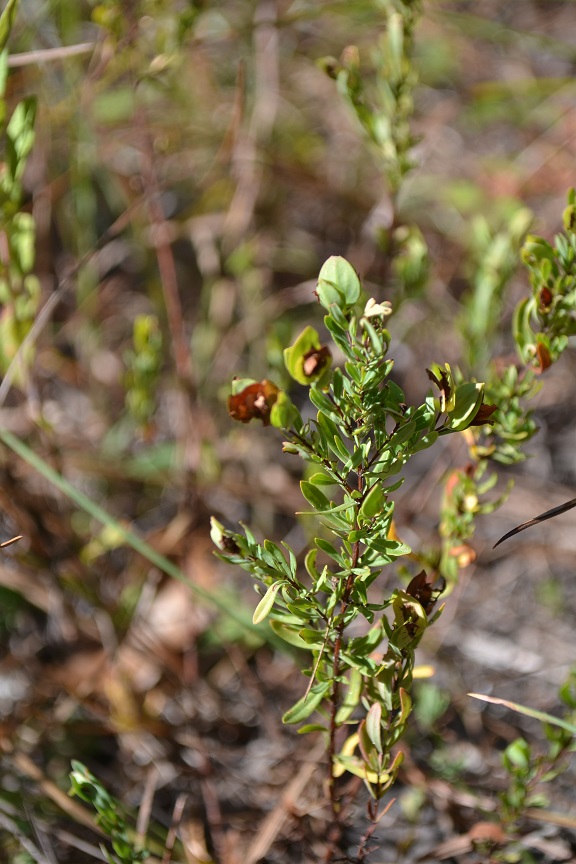Difference between revisions of "Hypericum hypericoides"
(→Ecology) |
|||
| Line 29: | Line 29: | ||
===Habitat=== <!--Natural communities, human disturbed habitats, topography, hydrology, soils, light, fire regime requirements for removal of competition, etc.--> | ===Habitat=== <!--Natural communities, human disturbed habitats, topography, hydrology, soils, light, fire regime requirements for removal of competition, etc.--> | ||
| − | ''H. hypericoides'' occurs in wet or moist loamy soils and semi-shady to open light conditions (FSU Herbarium). It can be found in annually burned longleaf pineland, wetland depressions, limestone glades, and by ponds (FSU Herbarium). However, it also appears in disturbed areas including roadsides, open fields, and pine plantations (FSU Herbarium). | + | ''H. hypericoides'' occurs in wet or moist loamy soils and semi-shady to open light conditions (FSU Herbarium). It can be found in annually burned longleaf pineland, wetland depressions, limestone glades, and by ponds (FSU Herbarium). However, it also appears in disturbed areas including roadsides, open fields, and pine plantations (FSU Herbarium). It has been associated with areas that are heavily logged, herbicided for woody plants, and burned several times, as compared to unlogged areas that are selectively herbicided for hardwoods and infrequently burned.<ref>Cipollini, M. L., J. Culberson, et al. (2012). "Herbaceous plants and grasses in a mountain longleaf pine forest undergoing restoration: a survey and comparative study." Southeastern Naturalist 11: 637-668.</ref> Associated species include ''Pinus palutris'' and ''Pinus elliottii'' (FSU Herbarium). |
| − | |||
| − | It has been associated with areas that are heavily logged, herbicided for woody plants, and burned several times, as compared to unlogged areas that are selectively herbicided for hardwoods and infrequently burned.<ref>Cipollini, M. L., J. Culberson, et al. (2012). "Herbaceous plants and grasses in a mountain longleaf pine forest undergoing restoration: a survey and comparative study." Southeastern Naturalist 11: 637-668.</ref> | ||
===Phenology=== <!--Timing off flowering, fruiting, seed dispersal, and environmental triggers. Cite PanFlora website if appropriate: http://www.gilnelson.com/PanFlora/ --> | ===Phenology=== <!--Timing off flowering, fruiting, seed dispersal, and environmental triggers. Cite PanFlora website if appropriate: http://www.gilnelson.com/PanFlora/ --> | ||
Revision as of 19:50, 14 December 2015
| Hypericum hypericoides | |
|---|---|

| |
| Photo taken by Kevin Robertson | |
| Scientific classification | |
| Kingdom: | Plantae |
| Division: | Magnoliophyta - Flowering plants |
| Class: | Magnoliopsida – Dicotyledons |
| Order: | Theales |
| Family: | Clusiaceae ⁄ Guttiferae |
| Genus: | Hypericum |
| Species: | H. hypericoides |
| Binomial name | |
| Hypericum hypericoides (L.) Crantz | |

| |
| Natural range of Hypericum hypericoides from USDA NRCS Plants Database. | |
Common name: St. Andrew's cross
Contents
Taxonomic notes
Description
Hypericum hypericoides is a perennial shrub species.
Distribution
Ecology
Habitat
H. hypericoides occurs in wet or moist loamy soils and semi-shady to open light conditions (FSU Herbarium). It can be found in annually burned longleaf pineland, wetland depressions, limestone glades, and by ponds (FSU Herbarium). However, it also appears in disturbed areas including roadsides, open fields, and pine plantations (FSU Herbarium). It has been associated with areas that are heavily logged, herbicided for woody plants, and burned several times, as compared to unlogged areas that are selectively herbicided for hardwoods and infrequently burned.[1] Associated species include Pinus palutris and Pinus elliottii (FSU Herbarium).
Phenology
Flowering has been observed in March and September, while fruiting has been observed in September (FSU Herbarium).
Seed dispersal
Seed bank and germination
Fire ecology
This species has been found in habitat that is burned annually, indicating some level of fire tolerance (FSU Herbarium).
Pollination
Use by animals
Diseases and parasites
Conservation and Management
Cultivation and restoration
Photo Gallery
References and notes
Florida State University Robert K. Godfrey Herbarium database. URL: http://herbarium.bio.fsu.edu. Last accessed: June 2014. Collectors: Ann F. Johnson, Wilson Baker, Loran C. Anderson, Leon Neel, R. Komarek, R.A. Norris, R.F. Doren, Robert K. Godfrey, Andre F. Clewell, Kevin Oakes, Chris Cooksey, and Sidney McDaniel. States and Counties: Florida: Franklin, Jackson, Jefferson, Lee, Leon, and Wakulla. Georgia: Baker and Thomas. Texas: Orange. Other Countries: Dominican Republic.
- ↑ Cipollini, M. L., J. Culberson, et al. (2012). "Herbaceous plants and grasses in a mountain longleaf pine forest undergoing restoration: a survey and comparative study." Southeastern Naturalist 11: 637-668.